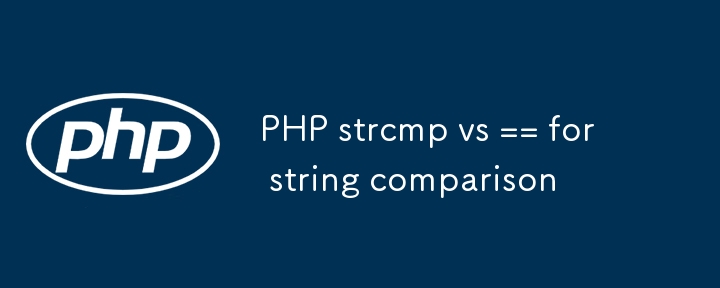To compare PHP strings, you should choose different methods according to your needs, and you cannot blindly use ==. Strictly compare it with ===, and strcmp() is used for dictionary order comparison. 1. == is unreliable, and will perform type conversion, resulting in unexpected results, such as '0e123' == '0' is true; 2. === is the safest comparison method, and the judgment is completely consistent and the type is not converted; 3. strcmp() is used to compare strings in dictionary order, returning -1, 0, and 1 to represent size relationships, and is case sensitive; 4. Safe scenarios must avoid ==, and === is better in performance. Pay special attention to traps when comparing null or boolean values.

When comparing strings in PHP, many people are confused about using strcmp() function or the == operator. In fact, the behaviors of the two are not exactly the same, and there are differences in usage scenarios.

To put it directly into the point: If you are going to do a strict string comparison, you should prioritize other methods rather than == . And strcmp() has its scope of application, but it is not omnipotent.
1. == is not a real "string comparison"
You may think that writing 'abc' == 'abc' is a string comparison, but in some cases, PHP's == will do something unexpected.

For example:
'0e123' == '0' // Return true
This is because in loose comparisons, PHP tries to convert strings to numbers. If both sides look like scientific notation (such as starting with 0e ), they are treated as floating point numbers, and the result is 0 == 0 .

So, when you want to compare if two strings are literally the same , == is not reliable.
2. === is a safer alternative
If you just want to determine whether the two strings are exactly the same (including case, character order, length, etc.), you should use === , which will not perform type conversion.
for example:
'abc' === 'abc' // true '0e123' === '0' // false
This comparison method is more intuitive and easier to understand than strcmp() . Especially when verifying user input or sensitive data (such as password hash), it is necessary to use strict comparison.
3. The purpose of strcmp() : sorting and case sensitivity
So what does strcmp() do? It is mainly used to compare strings in dictionary order , returning an integer value to represent the size relationship between two strings:
- Return value < 0: The first string is smaller than the second
- Return value = 0: Two strings are equal
- Return value > 0: The first string is greater than the second
For example:
strcmp('apple', 'banana') // -1 strcmp('hello', 'hello') // 0
This function is useful when sorting, searching, or when you need to know the order of strings. And it is case sensitive, that is, 'Apple' and 'apple' will be considered different.
There is also a case-insensitive version that is strcasecmp() , which can be selected as needed.
4. Small details on safety and performance
- Security : Do not use
==to compare password hash or tokens, because you may encounter magic hash problems, resulting in wrong matches. - Performance :
===is usually faster thanstrcmp()because it does not require calculating the string order, it only needs to determine whether it is completely consistent. - Note the null trap :
==can produce strange results if one of the operands isnullor boolean. For example,'abc' == nullistrue, but'abc' === nullis a reasonable judgment.
Basically that's it. You can decide which method to use according to actual needs:
- Decision is exactly consistent →
=== - Requires dictionary order →
strcmp() - Comparison of case-insensitive order →
strcasecmp() - Never use it in sensitive occasions
==
The above is the detailed content of PHP strcmp vs == for string comparison. For more information, please follow other related articles on the PHP Chinese website!

Hot AI Tools

Undress AI Tool
Undress images for free

Undresser.AI Undress
AI-powered app for creating realistic nude photos

AI Clothes Remover
Online AI tool for removing clothes from photos.

Clothoff.io
AI clothes remover

Video Face Swap
Swap faces in any video effortlessly with our completely free AI face swap tool!

Hot Article

Hot Tools

Notepad++7.3.1
Easy-to-use and free code editor

SublimeText3 Chinese version
Chinese version, very easy to use

Zend Studio 13.0.1
Powerful PHP integrated development environment

Dreamweaver CS6
Visual web development tools

SublimeText3 Mac version
God-level code editing software (SublimeText3)
 PHP Variable Scope Explained
Jul 17, 2025 am 04:16 AM
PHP Variable Scope Explained
Jul 17, 2025 am 04:16 AM
Common problems and solutions for PHP variable scope include: 1. The global variable cannot be accessed within the function, and it needs to be passed in using the global keyword or parameter; 2. The static variable is declared with static, and it is only initialized once and the value is maintained between multiple calls; 3. Hyperglobal variables such as $_GET and $_POST can be used directly in any scope, but you need to pay attention to safe filtering; 4. Anonymous functions need to introduce parent scope variables through the use keyword, and when modifying external variables, you need to pass a reference. Mastering these rules can help avoid errors and improve code stability.
 How to handle File Uploads securely in PHP?
Jul 08, 2025 am 02:37 AM
How to handle File Uploads securely in PHP?
Jul 08, 2025 am 02:37 AM
To safely handle PHP file uploads, you need to verify the source and type, control the file name and path, set server restrictions, and process media files twice. 1. Verify the upload source to prevent CSRF through token and detect the real MIME type through finfo_file using whitelist control; 2. Rename the file to a random string and determine the extension to store it in a non-Web directory according to the detection type; 3. PHP configuration limits the upload size and temporary directory Nginx/Apache prohibits access to the upload directory; 4. The GD library resaves the pictures to clear potential malicious data.
 Commenting Out Code in PHP
Jul 18, 2025 am 04:57 AM
Commenting Out Code in PHP
Jul 18, 2025 am 04:57 AM
There are three common methods for PHP comment code: 1. Use // or # to block one line of code, and it is recommended to use //; 2. Use /.../ to wrap code blocks with multiple lines, which cannot be nested but can be crossed; 3. Combination skills comments such as using /if(){}/ to control logic blocks, or to improve efficiency with editor shortcut keys, you should pay attention to closing symbols and avoid nesting when using them.
 How Do Generators Work in PHP?
Jul 11, 2025 am 03:12 AM
How Do Generators Work in PHP?
Jul 11, 2025 am 03:12 AM
AgeneratorinPHPisamemory-efficientwaytoiterateoverlargedatasetsbyyieldingvaluesoneatatimeinsteadofreturningthemallatonce.1.Generatorsusetheyieldkeywordtoproducevaluesondemand,reducingmemoryusage.2.Theyareusefulforhandlingbigloops,readinglargefiles,or
 Tips for Writing PHP Comments
Jul 18, 2025 am 04:51 AM
Tips for Writing PHP Comments
Jul 18, 2025 am 04:51 AM
The key to writing PHP comments is to clarify the purpose and specifications. Comments should explain "why" rather than "what was done", avoiding redundancy or too simplicity. 1. Use a unified format, such as docblock (/*/) for class and method descriptions to improve readability and tool compatibility; 2. Emphasize the reasons behind the logic, such as why JS jumps need to be output manually; 3. Add an overview description before complex code, describe the process in steps, and help understand the overall idea; 4. Use TODO and FIXME rationally to mark to-do items and problems to facilitate subsequent tracking and collaboration. Good annotations can reduce communication costs and improve code maintenance efficiency.
 Quick PHP Installation Tutorial
Jul 18, 2025 am 04:52 AM
Quick PHP Installation Tutorial
Jul 18, 2025 am 04:52 AM
ToinstallPHPquickly,useXAMPPonWindowsorHomebrewonmacOS.1.OnWindows,downloadandinstallXAMPP,selectcomponents,startApache,andplacefilesinhtdocs.2.Alternatively,manuallyinstallPHPfromphp.netandsetupaserverlikeApache.3.OnmacOS,installHomebrew,thenrun'bre
 How to access a character in a string by index in PHP
Jul 12, 2025 am 03:15 AM
How to access a character in a string by index in PHP
Jul 12, 2025 am 03:15 AM
In PHP, you can use square brackets or curly braces to obtain string specific index characters, but square brackets are recommended; the index starts from 0, and the access outside the range returns a null value and cannot be assigned a value; mb_substr is required to handle multi-byte characters. For example: $str="hello";echo$str[0]; output h; and Chinese characters such as mb_substr($str,1,1) need to obtain the correct result; in actual applications, the length of the string should be checked before looping, dynamic strings need to be verified for validity, and multilingual projects recommend using multi-byte security functions uniformly.
 Learning PHP: A Beginner's Guide
Jul 18, 2025 am 04:54 AM
Learning PHP: A Beginner's Guide
Jul 18, 2025 am 04:54 AM
TolearnPHPeffectively,startbysettingupalocalserverenvironmentusingtoolslikeXAMPPandacodeeditorlikeVSCode.1)InstallXAMPPforApache,MySQL,andPHP.2)Useacodeeditorforsyntaxsupport.3)TestyoursetupwithasimplePHPfile.Next,learnPHPbasicsincludingvariables,ech






